Gloucestershire Volunteer Artillery
266 (Gloucestershire Volunteer Artillery) Battery Royal Artillery is a Royal Artillery unit of the British Army Reserve. It was first formed in Bristol in 1859 and served through World War I as field artillery and World War II as anti-aircraft (AA) artillery.
| Gloucestershire Volunteer Artillery 1st (South Midland) Brigade, RFA (TF) 76th (Gloucestershire) AA Regiment, RA (TA) 266th (GVA) Battery, Royal Artillery | |
|---|---|
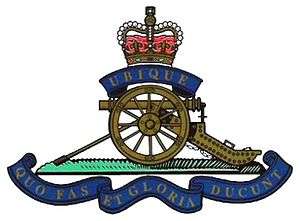 Cap Badge of the Royal Artillery | |
| Active | 22 November 1859 – present |
| Country | |
| Branch | |
| Role | Field Artillery Anti-Aircraft Artillery Light Artillery |
| Size | Up to 13 Batteries (to 1908); Brigade/Regiment (1908–55) One battery (present) |
| Peacetime HQ | Whiteladies Road, Clifton, Bristol |
| Nickname(s) | The Bristol Gunners |
| Motto(s) | Fides et Audax |
| Equipment | L118 light gun (present) |
| Engagements |
|
Volunteer Artillery 1859-1908
The enthusiasm for the Volunteer movement following an invasion scare in 1859 saw the creation of many Volunteer units composed of part-time soldiers eager to supplement the Regular British Army in time of need.[1][2] In November that year the Earl of Ducie, Lord Lieutenant of Gloucestershire, organised a unit of Gloucestershire Artillery Volunteers in Bristol under the command of Major Henry Bourchier Osborne Savile, a former Royal Artillery officer. The Society of Merchant Venturers in Bristol provided land in Whiteladies Road, Clifton, to build its headquarters (HQ), known as 'the Artillery Grounds'. Four smoothbore 18-pounder guns were obtained from Woolwich and arrived in Bristol in April 1860. Further Artillery Volunteer Corps (AVCs) were quickly organised in the county of Gloucestershire and in 1863 they were brigaded together[lower-alpha 1] with those from neighbouring Somerset (dates are those of the first officers' commissions):[5][6][7][8][9][10]
1st Administrative Brigade, Gloucestershire Artillery Volunteers
- HQ: Whiteladies Road, Clifton
- 1st (Bristol) Gloucestershire AVC (21 December 1859; initially five batteries, No 6 Battery raised October 1872)
- 2nd (Newnham on Severn) Gloucestershire AVC (1 March 1860)
- 3rd (Gloucester) Gloucestershire AVC (26 July 1860)
- 4th (Forest of Dean) Gloucestershire AVC (1 September1861; attached to 1st August 1863; merged into 2nd January 1864)
- 1st (Clevedon) Somerset AVC (18 June 1860)
- 2nd (Weston-super-Mare) Somerset AVC (30 July 1860; disbanded 1867)
- 2nd Gloucestershire Engineer Volunteer Corps (10 April 1861; attached from August 1862 until June 1864)[7][11]
In 1863 a subscription by 'Bristol ladies' purchased two Whitworth 3-pounder guns.[10]
Major Savile was appointed Lieutenant-Colonel of the administrative brigade on 28 November 1863. He was succeeded as Major Commandant of the 1st Gloucester AVC by Lord Glentworth, a former officer in the Rifle Brigade. Savile retired in 1873, becoming Honorary Colonel of the unit, when Brevet Colonel Arthur Blunt, formerly of the Bombay Artillery, became commanding officer (CO) of the brigade, and shortly afterwards of the 1st AVC as well.[12][13]
The brigade was consolidated in March 1880 under the command of Lt-Col Adolphus H. Versturme, formerly of the 59th Foot, as:[6][7][8][10][13]
1st Gloucestershire (Gloucester and Somerset) AVC
- HQ at Bristol
- Nos 1–6 Batteries at Bristol
- No 7 Battery at Newnham
- No 8 Battery at Gloucester
- No 9 Battery at Clevedon
Further batteries were added in following years: No 10 at Portishead, No 11 at Weston-Super-Mare, No 12 at Clevedon and No 13 at Bedminster. A Cadet Corps with HQ at Bristol also existed from 1880 to 1884.[6][7][13] The 1st Gloucester AVC was assigned to the Welsh Division of the Royal Artillery (RA) on 1 April 1882, changing to the Western Division on 1 July 1889.[6][8][10][13] By 1893 the War Office Mobilisation Scheme had allocated the 1st Gloucestershire Artillery Volunteers to the Plymouth fixed defences.[14]
Frederick Cusac Ord, a former captain in the Royal Artillery, was appointed Major on 25 April 1885, became Lt-Col commanding on 7 December 1889 and Lt-Col Commandant on 1 April 1891. Lieutenant-Colonel Sir Edmund Elton, 8th Baronet, commissioned as Captain on 24 September 1881, became Major on 19 August 1893.[13]
On 1 January 1902 the RA divisional organisation was abolished, and the unit was assigned to the Royal Garrison Artillery (RGA) as 1st Gloucestershire (Gloucester and Somerset) RGA (Volunteers).[6][8][13]
Territorial Force
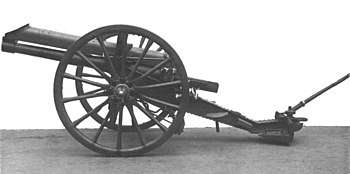
When the Volunteers were subsumed into the new Territorial Force (TF) under the Haldane Reforms of 1908,[15][16] the unit was to become the II (or 2nd) South Midland (Gloucestershire) Brigade, Royal Field Artillery (RFA), but this was changed in 1910 to I (or 1st) South Midland (Gloucestershire) Brigade,RFA. It formed part of the South Midland Division of the TF, with the following organisation (each battery consisted of four 15-pounder guns):[7][8][10][13][17][18][19][20][21][22]
- HQ: Artillery Grounds, Clifton
- 1st Gloucestershire Battery, Clifton
- 2nd Gloucestershire Battery, Clifton
- 3rd Gloucestershire Battery, Barracks, Gloucester
- 1st South Midland Ammunition Column, Clifton
World War I
Mobilisation
On the outbreak of war, I SM Bde mobilised at Clifton and Gloucester and initially went to its war station in the defences of the Naval base at Plymouth. It then joined the concentration of the South Midland Division around Chelmsford, where it formed part of Central Force.[19][21] On the outbreak of war, units of the TF were invited to volunteer for Overseas Service. On 15 August 1914, the War Office issued instructions to separate those men who had signed up for Home Service only, and form these into reserve units. On 31 August, the formation of a reserve or 2nd Line unit was authorised for each 1st Line unit where 60 per cent or more of the men had volunteered for Overseas Service. The titles of these 2nd Line units would be the same as the original, but distinguished by a '2/' prefix. In this way duplicate battalions, brigades and divisions were created, mirroring those TF formations being sent overseas.[19][23]
1/I South Midland Brigade
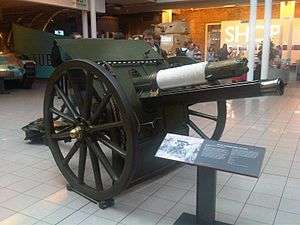
The South Midland Division was ordered to France on 13 March 1915, and the artillery embarked at Southampton for Le Havre on 29 March, disembarkation being complete by 1 April. By 4 April the division had taken over a section of the front line near Neuve Eglise in Belgium. It was redesignated 48th (South Midland) Division on 12 May 1915. The batteries were re-equipped with modern 18-pounder guns on 21 July.[19][21][22][24]
The brigade was redesignated CCXL Brigade, RFA, (240 Bde) on 18 May 1916. At the same time the batteries were redesignated A, B and C, a new D Bty having already been formed on 3 April. D Battery with its 18-pounders was then swapped for D (Howitzer) Bty of CCXLIII (IV South Midland) Bde. This battery had previously been 4th Warwickshire Bty, and was equipped with 4.5-inch howitzers. Brigade Ammunition Columns were also abolished at this time. On 18 October 1916 the 18-pounder batteries were brought up to six-gun strength when the brigade's former D Bty (now A/CCXLIII) returned and half of C/CCXLIII Bty joined. Similarly, D (H) Bty was brought up to a strength of six howitzers when half of C (H)/CCXLII (III South Midland) Bty joined on 16 January 1917.[8][10][18][21][22][19][25]
CCXL Bde supported 48th Division in the following actions:[21][22]
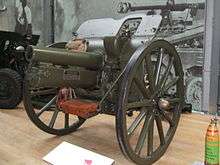
1916
- Battle of the Somme
- Battle of Albert (1 July)
- Battle of Bazentin Ridge (15–17 July)
- Capture of Ovillers (17 July)
- Battle of Pozieres Ridge (23–27 July, 13–28 August)
- Battle of the Ancre Heights (3–11 November)
- Battle of the Ancre (13–18 November)
1917
- German retreat to the Hindenburg Line (Operation Alberich) (14 March–5 April)
- Occupation of Peronne (18 March)
- Third Ypres Offensive[24]
- Battle of Langemarck (16 August) Although this battle was disastrous overall, the artillery support for 48th Division was good and it captured some ground before being held up by a group of fortified farms. On 20 August 48th Division took advantage of a spell of dry weather to attack the troublesome strongpoints that had held them up: Hillock Farm, Maison du Hibou, Triangle Farm and the Cockcroft. Seven tanks moved up the firm St Julien–Poelcapelle road covered by a smoke and shrapnel barrage, with a High Explosive (HE) barrage ahead, and subdued the strongpoints that were then captured by infantry platoons. A repeat of this attack two days later was less successful.[26][27][28]
- Battle of Polygon Wood (28 September–3 October)
- Battle of Broodseinde (4 October)
- Battle of Poelcappelle (9 October) This was the division's last attack on the Western Front. Its role was to advance up a ridge to the outskirts of the village of Passchendaele. Ground conditions were bad, and many batteries were bogged down, so the preparatory barrage was feeble, many of the HE shellbursts being deadened by the mud. Casualties among the gunners were also severe because they were exposed to German observers on the ridge.[29][30][31]
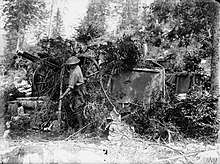
On 10 November, 48th Division was ordered to move to move to the Italian Front. Entrainment began on 21 November and by 1 December the division concentrated round Legnago in the Adige Sector. On 1 March 1918 the division relieved 7th Division in the front line of the Montello sector on the Piave Front, and held the line until 16 March. On 1 April it moved westward into reserve for the middle sector of the Asiago Plateau Front. It remained in Italy for the remainder of the war, taking part in the following operations:[21][22][32][33]
1918
- Battle of the Piave River:
- Fighting on the Asiago Plateau, 15–16 June 1918
- Battle of Vittorio Veneto:
- Fighting in the Val d'Assa, 1–4 November 1918
On 3 November 1918, at Osteria del Termine, the division surrounded and captured a large force of Austrian troops including the corps commander and three divisional commanders. By 15.00 on 4 November, when the Armistice with Austria came into force, the division had pushed forward into the Trentino. After the conclusion of hostilities the division was withdrawn to Italy for the winter. Demobilisation began in 1919 and was complete by 31 March.[10][21]
2/I South Midland Brigade
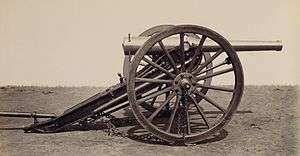
The 2nd Line brigade was formed in the autumn of 1914, and in January 1915 it joined the 2nd South Midland Division (later 61st (2nd South Midland) Division) at Northampton. Equipment was scarce, and until the end of 1915 the only guns available for training were obsolete French De Bange 90 mm guns. In January 1916 the brigade received four of the obsolescent 15-pounders that had equipped 1st Line TF units. Finally, as the division prepared to go overseas, modern 18-pounders were issued.[34][35]
While stationed at Northampton, the division formed part of First Army of Central Force, but once the 48th Division had gone to France, the 61st replaced it around Chelmsford as part of Third Army, Central Force, responsible for coastal defence. In February 1916 the division moved to Salisbury Plain for final battle training. In May it concentrated in the Tidworth–Bulford area, and on 16/17 May 1916 2/I (SM) brigade was redesignated CCCV Brigade RFA (305 Bde).[8][10][18][19][25][34]
Entrainment for the embarkation ports began on 21 May and by 28 May the division was in France, concentrated in IX Corps' area behind the front line. The division's first major action was the Attack at Fromelles on 19 July 1916. The artillery preparation had begun the previous day, but the infantry attack was a disaster, the assaulting battalions taking very heavy casualties. 61st Division was only used for trench-holding for the rest of the year. On 16/17 September CCCV (2/I SM) Brigade was broken up among the other artillery brigades of 61st Division to bring them up to 6-gun batteries.[25][34][35][36][10]
Inter War Years
When the TF was reconstituted on 7 February 1920 the 1st South Midland Bde reformed with 1st–3rd Gloucestershire Batteries, joined by the former Berkshire Royal Horse Artillery at Reading as a fourth battery (the Berkshire Bty). The TF was reorganised as the Territorial Army (TA) in 1921 and the unit was redesignated as 66th (South Midland) Brigade, RFA. The brigade continued to form part of 48th (South Midland) Division. The title changed to 66th (South Midland) Field Brigade, RA, in January 1924 when the RFA was subsumed into the RA.[8][10][18][13][37][38]
- HQ: Artillery Grounds, Clifton
- 261st (Bristol) Field Battery, Clifton
- 262nd (Bristol) Field Battery, Clifton
- 263rd (Bristol) Field Battery, Clifton
- 264th (Berkshire) Field Battery (Howitzers), Yeomanry House, Reading
The Clifton College contingent of the Officers' Training Corps (Junior Division) was attached to the unit in the 1930s.[13]
Anti-Aircraft conversion
During the 1930s the increasing need for anti-aircraft (AA) defence for Britain's cities was addressed by converting a number of existing TA units. The 66th (South Midland) Field Brigade was one of the units converted to the AA artillery role on 1 November 1938, becoming 76th (Gloucestershire) Anti-Aircraft Regiment, RA. 264 Battery at Reading was separated and expanded to form a new 80th (Berkshire) AA Rgt. The HQ and three remaining batteries (renumbered as 236, 237 and 238 (Bristol) AA Btys) were all based at the Artillery Grounds at Clifton. It formed part of 46th Anti-Aircraft Brigade in 5 AA Division, which provided the AA defence for Bristol, including Bristol Docks and the Bristol Aeroplane Company factory at Filton Aerodrome, a key target.[8][18][13][37][39][40][41][42]
World War II
Mobilisation
The TA's AA units were mobilised on 23 September 1938 during the Munich Crisis, with units manning their emergency positions within 24 hours, even though many did not yet have their full complement of men or equipment. The emergency lasted three weeks, and they were stood down on 13 October.[43] In February 1939 the existing AA defences came under the control of a new Anti-Aircraft Command. In June a partial mobilisation of TA units was begun in a process known as 'couverture', whereby each AA unit did a month's tour of duty in rotation to man selected AA and searchlight positions. On 24 August, ahead of the declaration of war, AA Command was fully mobilised at its war stations, with the eight 3-inch guns of 76th AA Rgt deployed as planned in and around the Bristol Gun Defence Area (GDA) – four of them out of action.[44][45]
On 11 September 1939 all the available heavy AA (HAA) guns in 46 AA Bde (76th AA Rgt's eight guns) were concentrated to cover Avonmouth Docks. These guns were relocated to Filton Aerodrome in October. In the near-total absence of light AA (LAA) guns, detachments from other units armed with Light machine guns were deployed during October to cover Vulnerable Points (VPs) such as airfields and aircraft factories. 76th AA Regiment manned 16 Lewis guns at Parnall Aircraft, Yate, until they were relieved by 68th (Monmouthshire Regiment) Searchlight Rgt in November.[45]
From 1 June 1940 those AA units armed with 3-inch or the more modern 3.7-inch guns were termed 'Heavy AA' (HAA) to distinguish them for the Light AA units then being formed.[8][18][39][46]
Battle of Britain and Blitz

By 11 July 1940, at the start of the Battle of Britain, 5 AA Division had 36 HAA guns deployed at Bristol.[47] Some of the greatest air battles of the Battle of Britain were fought on 15 August, from South Wales to the Yorkshire Coast, when 5 AA Division was hotly engaged, being credited with several 'kills'. Another peak day came on 24 August, when the Bristol gunners were in action again. From 6 September the Luftwaffe switched from bombing airfields to bombing cities, and there was a daylight raid on Bristol on 25 September 1940.[48][49]
As AA Command expanded, the regiment formed a new 349 HAA Bty formed on 17 September, and 46 AA Bde transferred to a new 8 AA Division in November.[39][40][50][51][52] Now the night attacks were stepped up against London and other cities, with Bristol receiving frequent raids, particularly heavy in March 1941 (the Bristol Blitz).[53][54][55][56]
The regiment sent a cadre to 207th Training Regiment at Devizes to provide the basis for a new 425 HAA Bty; this was formed on 24 April 1941 and later joined 126th HAA Rgt. The regiment sent another cadre to 207th HAA Training Regiment to provide the basis for a new 480 (Mixed) HAA Bty, in which women of the Auxiliary Territorial Service were integrated. This battery was formed on 18 September 1941 but was converted to men-only on 15 October before being regimented with 76th HAA Rgt on 9 December.[39] It replaced 238 HAA Bty, which left in October–November to join the field force under War Office control and later transferred to 83rd (Blythswood) AA Rgt.[39][57] In the autumn of 1941 the regiment (with 236, 237 and 349 HAA Btys) joined a new 69 AA Bde in 8 AA Division.[58]
Mobilising for overseas service
The regiment was now prepared for overseas service. This required a war establishment of three batteries, and 480 HAA Bty was reduced back to a cadre on 9 April 1942 to return to Devizes and form a new 480 (Mixed) Bty; this battery eventually joined 162nd HAA Rgt[39] The rest of the regiment had left AA Command by May 1942.[59] By September 1942 it had come under War Office Control, with its own Royal Corps of Signals Section and Royal Army Ordnance Corps Workshop Section.[60] It was joined by a Royal Army Service Corps transport platoon in the autumn of 1942 and was now ready for overseas service as a mobile unit.[61]
Tunisia
In October 1942 the advance parties of the regiment sailed for North Africa as part of Operation Torch, and began unloading their equipment in Algiers harbour soon after it was secured on 9 November. However, the HAA units had not been 'combat loaded' and it took some time to assemble the 3.7-inch guns, vehicles and equipment and deploy to engage the Luftwaffe air attacks that quickly developed against the port and nearby airfields. It was not until the end of the year that the regiment was at full strength, but by mid-January 1943 it had a battery in action at Algiers port, and troops at Maison Blanche and Blida airfields, all under 62 AA Bde. These were regularly attacked by German bombers flying from Sicily and Sardinia. On one occasion, 13 Allied aircraft were destroyed and many damaged during a night raid on Maison Blanche. As the campaign developed and First Army advanced eastwards, the regiment had full batteries deployed in 'Inner Artillery Zones' (IAZs) at Algiers, Bougie and Djidjelli by mid-March. In these positions the gunners found that the performance of their gun-laying (GL) radar sets was degraded by nearby hills and it was difficult to engage 'unseen' targets.[46][62][63][64]
By late April, 62 AA Bde had been relieved round Algiers by US Army units, and was able to move up behind First Army. 76th HAA Regiment now joined 52 AA Bde, which consisted of a mobile AA force for the final push in Tunisia (Operation Vulcan). These units were ready to move into Tunis and Bizerta immediately behind the leading battle groups. Despite German counter-attacks, 'Vulcan' was launched on 6 May and in the afternoon of 7 May Allied troops entered the two cities and 52 AA Bde was called forward. In fact, enemy combat troops were still holding out, and at Bizerta the AA advance parties came under shellfire from outside the town. Once the last resistance had been flushed out, 76 HAA Rgt deployed in the Bizerta IAZ. Because of the port's vital importance for the assembly and despatch of forces for the Allied invasion of Sicily (Operation Husky) this became the largest British AA commitment in the theatre.[65][66]
Sicily
The assault landings on Sicily began on 10 July 1943, Syracuse was entered that night, and 62 AA Bde HQ landed there on 17 July, bringing with it batteries from 76th HAA and other regiments, which were dispersed and deployed where required. The vital harbours at Syracuse and Augusta received constant raids from Luftwaffe bombers and fighters by day and night, with the AA gunners scoring several 'kills'. By D+28 (7 August), 76th HAA Rgt was deployed round Syracuse with 236 HAA Bty detached to Augusta.[46][67][68][69]
Italy
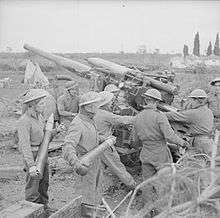
Messina fell on 17 August, completing the capture of Sicily, and the Allies moved quickly to the invasion of the Italian mainland, beginning with Eighth Army crossing the Straits of Messina on 3 September (Operation Baytown). 62 AA Brigade HQ followed on 29 September, taking 76 HAA Rgt with it. Travelling by road, it crossed Italy and reached Bari on 2 October, it relieved the AA units there to follow the advance and took over defence of Bari harbour, Barletta and Manfredonia on the coast, and a complex of inland airfields. The ports were important for Eighth Army's supplies, and were targeted by the Luftwaffe. On the night of 2/3 December there was an Air raid on Bari covered by clouds of 'Window' (known as Düppel to the Luftwaffe). Not only were the Royal Air Force and Royal Artillery radar stations blinded, but communications broke down between the two services and defensive fire only began as the first bombs fell. The guns claimed three bombers shot down. The bombers had been aided by the port working under full lighting, and the damage to shipping and stores was increased by the explosion of an ammunition vessel.[46][70][71][72]
Shortly after the Bari raid, 62 AA Bde HQ and 76 HAA Rgt were relieved and moved on up the eastern side of the Italian peninsula behind Eighth Army, crossing to join US Fifth Army in April 1944. Initially it was involved in airfield defence, but after Fifth Army's capture of Rome in June 1944 it deployed to defend the bridges over the Tiber and the port of Piombino. Then when relieved it was able to follow close behind Fifth Army. Although the Luftwaffe's losses meant the air threat was lowered, HAA batteries of 62 AA Bde also employed their versatile long-range 3.7-inch guns in a medium artillery role against ground targets. This included counter-battery (CB), defensive fire (DF) and harassing fire (HF) shoots, but also air-burst shoots against entrenched positions, and destruction of hard targets such as buildings.[73]
Once Fifth Army had crossed the Arno, it faced the Serchio and the defences of the Gothic Line. On 26 December the German forces put in a major counterattack, Unternehmen Wintergewitter (Operation Winter Storm), between Lucca and Pistoia aimed at retaking the port of Livorno (Leghorn). 62 AA Brigade was well to the front in the resulting Battle of Garfagnana, with LAA regiments acting as infantry and anti-tank gunners, while the HAA regiments acted as divisional medium artillery. 76th HAA Regiment answered 181 calls for fire with 4995 rounds fired. Having beaten off the attack, IV US Corps advanced into the mountains. There was little activity by the Luftwaffe, so the ample stocks of 3.7-inch AA ammunition were used for all kinds of engagements. By the end of February 1945, 62 AA had been reduced to just two regiments – of which 76th was one – with only one battery on AA tasks.[74][75][76]
Fifteenth Army Group (British Eighth and US Fifth Armies) launched its final offensive (Operation Grapeshot) on 6 April 1945 and the Italian Campaign ended shortly afterwards. 76th (Gloucester) Heavy Anti-Aircraft Regiment and its three batteries were placed in suspended animation on 24 November 1945.[18][39][75][77]
Post-war
When the TA was reconstituted on 1 January 1947 the regiment was reformed as 266 (Gloucestershire Volunteer Artillery) HAA Rgt, RA in 72 AA Bde (the former 46 AA Bde at Bristol).[8][18][39][78][79] (On 1 April 1947 the Regular Army's 1st HAA Rgt took the GVA's old number and became 76 HAA Rgt.[80])
When AA Command was disbanded in 1955 there were wholesale mergers among its units. 266 HAA Regiment was amalgamated with 312 (Gloucestershire) and 601 (City of Bristol) HAA Rgts to form 'P' (Gloucestershire Volunteer Artillery) Battery in the new 311 (City of Bristol) HAA Rgt. In 1961 that regiment was merged into 883 (Bristol) Locating Battery to form 883 (Gloucestershire Volunteer Artillery) Locating Battery.[8][18][78][79][81][82][83][84]
A further reorganisation in 1967 saw the battery converted to infantry as 'A' (Gloucestershire Volunteer Artillery) Squadron in the Royal Gloucestershire Hussars. This regiment was reduced to a cadre at Bristol in 1969, but two years later 266 (Gloucestershire Volunteer Artillery) OP Battery was reformed from the cadre as an independent Observation Post unit as a reinforcement unit for BAOR supplying observation post teams. In 1999 this re-roled as a field battery in 100th (Yeomanry) Regiment Royal Artillery as the TA battery supporting 7 Para RHA and 29 Commando Regiment. The Romford based 289th Parachute Troop, Royal Artillery formed part of the battery from 1999 to 2007.[8][79][81][85][86]
Under Army 2020 plans, 266th Battery re-roled to Mini Unmanned Air Systems was assigned to 104th Regiment Royal Artillery.[87]
Uniforms and insignia
The original officers' uniform of the 1st Gloucestershire AVC was a long-skirted blue tunic with scarlet cuffs, collar and edging, five rows of black braid across the front and black Austrian knots on the sleeves. Other ranks wore a blue tunic with black Austrian knots. A peaked forage cap was worn with a silver grenade on the front, with white waist and cross belts. A busby became the full dress headgear in the 1860s and was worn until 1908.[7][10]
During the period 1908–19, the Gloucester TF batteries wore a brass shoulder title, 'T/RFA/GLOSTER', while the brigade ammunition column wore 'T/RFA/S.MIDLAND'. However at some point the batteries wore a non-regulation embroidered shoulder title 'GLOS/RFA/T', in red on a dark blue backing.[18]
From 1961 to 1967, 883 Locating Battery wore an embroidered title 'GLOUCESTERSHIRE/VOLUNTEER ARTILLERY' in red on dark blue. This remained in wear for A (GVA) Squadron, Royal Gloucestershire Hussars from 1967 to 1971. In 1971 the reformed 266 OP Battery introduced a black embroidered slip-on title 'G.V.A.' worn on the shoulder straps of the barrack jersey; other ranks wore the title in white metal.[18]
Honorary Colonels
The following officers served as Honorary Colonel of the unit:[12][13]
- Col Henry Bourchier Osborne Savile, CB, VD, former CO, appointed 9 August 1873
- Col Frederick Cusac Ord, CB, VD, TD, former CO, appointed 8 December 1909
- Lt-Gen Sir Percy P. de B. Radcliffe, KCMG, CB, DSO, RA officer and former commander of 48th (SM) Division, appointed 24 April 1926
- Lt-Col Francis Killigrew Seymour Metford, CB, OBE, VD, TD, appointed 12 May 1934
Notes
- The basic organic unit of the Royal Artillery was, and is, the Battery.[3] When grouped together they formed brigades, in the same way that infantry battalions or cavalry regiments were grouped together in brigades. At the outbreak of World War I, a field artillery brigade of headquarters (4 officers, 37 other ranks), three batteries (5 and 193 each), and a brigade ammunition column (4 and 154)[4] had a total strength just under 800 so was broadly comparable to an infantry battalion (just over 1,000) or a cavalry regiment (about 550). Like an infantry battalion, an artillery brigade was usually commanded by a Lieutenant-Colonel. Artillery brigades were redesignated as regiments in 1938. Note that the battery strength refers to a battery of six guns; a four-gun battery would be about two thirds of this.
References
- Beckett.
- Spiers, pp. 163–8.
- "The Royal Artillery". Ministry of Defence (United Kingdom). Archived from the original on 23 October 2013. Retrieved 18 November 2013.
- Baker, Chris. "What was an artillery brigade?". The Long, Long Trail. Retrieved 18 November 2013.
- Beckett, Appendix VIII.
- Frederick, pp. 658–9.
- Litchfield & Westlake, pp. 86–8, 153.
- "Gloucestershire Volunteer Artillery at Regiments.org". Archived from the original on 16 November 2005. Retrieved 16 November 2005.
- 1859–1908 at Bristol Gunners.
- Historical Records at Bristol Gunners.
- Westlake, p. 8.
- Officers Biographies at Bristol Gunners.
- Army List
- Mobilization Tables for Home Defence, List of Militia, Yeomanry and Volunteer Units, HMSO, London, 1893
- Dunlop, Chapter 14.
- Spiers, Chapter 10.
- Frederick, p. 680.
- Litchfield, pp. 84–6.
- 1908–1920 at Bristol Gunners
- London Gazette 20 March 1908.
- Becke, Pt 2a, pp. 77–83.
- 48 (SM) Division at Long, Long Trail.
- Becke, Pt 2b, p. 6.
- Farndale, Western Front, p. 94.
- Frederick, p. 692.
- Edmonds, 1917, Vol II, pp. 199–202.
- Farndale, p. 204, Map 27.
- John Lee, 'The British Divisions at Ypres', in Liddle (ed), pp. 217–9.
- Wolff, pp. 223–35.
- John Lee, 'The British Divisions at Third Ypres' in Liddle (ed), p. 221.
- Ashley Eakins, 'The Australians at Passchendaele', in Liddle (ed), pp. 239–40.
- Farndale, Western Front, p. 213.
- Wolff, p. 253.
- Becke, Pt 2b, pp. 33–39.
- 61 (SM) Division at Long, Long Trail.
- Farndale, Western Front, p. 133.
- Frederick, p. 518.
- Titles and Designations, 1927.
- Frederick, pp. 755–9, 774–5.
- 5 AA Division 1939 at British Military History.
- Routledge, Table LX, p. 378.
- AA Command 3 September 1939 at Patriot Files.
- Routledge, pp. 62–3.
- Routledge, pp. 65–6, 371, Table LIX, p. 377.
- 46 AA Bde War Diary 1939–40, The National Archives (TNA), Kew, file WO 166/2287.
- "76 (Gloucester) HAA Rgt at RA 39–45". Archived from the original on 26 October 2008. Retrieved 26 October 2008.
- Farndale, Years of Defeat, p. 106.
- Farndale, Years of Defeat, p. 108.
- Routledge, Table LXII, pp. 379–80.
- Farndale, Years of Defeat, Annex D.
- Routledge, Table LXV, p. 96.
- Order of Battle of Non-Field Force Units in the United Kingdom, Part 27: AA Command, 12 May 1941, with amendments, TNA file WO 212/79.
- Routledge, p. 394.
- Pile's despatch.
- Collier, Chapter 17.
- Collier, Appendix XXX.
- Order of Battle of the Field Force in the United Kingdom, Part 3: Royal Artillery (Non-Divisional units), 22 October 1941, TNA files WO 212/6 and WO 33/1883.
- Order of Battle of Non-Field Force Units in the United Kingdom, Part 27: AA Command, 2 December 1941, with amendments, TNA file WO 212/80.
- Order of Battle of Non-Field Force Units in the United Kingdom, Part 27: AA Command, 14 May 1942, TNA file WO 212/81.
- Order of Battle of the Field Force in the United Kingdom, Part 3: Royal Artillery (Non-Divisional units), 2 April 1942, with amendments, TNA files WO 212/515.
- Order of Battle of the Field Force in the United Kingdom, Part 3: Royal Artillery (Non-Divisional Units), 22 November 1942, TNA file WO 212/8.
- Joslen, p. 465.
- Routledge, pp. 178–85; Table XXX, p. 188; Table XXXI, p. 189.
- Playfair & Molony, Vol IV, pp. 146, 174, 252–3.
- Routledge, pp. 185–6; Table XXXII, p. 190.
- Playfair & Molony, Vol IV, p. 453.
- Joslen, p. 466.
- Molony, Vol V, pp. 59–64, 81.
- Routledge, pp. 261–3; Table XLII, p. 267.
- Joslen, p. 467.
- Molony, Vol V, pp. 182, 413–4.
- Routledge, pp. 265, 269, 274–5, 281.
- Routledge, pp. 275, 279–81, 284–5; Table XLIV, p. 293.
- Jackson, Vol VI, Pt III, pp. 126–9.
- Routledge, Table XLVI, p. 295.
- Routledge, p. 285; Table XLVII, pp. 296–7.
- Jackson, Vol VI, Pt III, pp. 253–333.
- Frederick, p. 999.
- A. Young. "Territorial Army - Royal Artillery » 266 - 288 Regiments 1947-67". British Army units from 1945 on. Retrieved 13 February 2015.
- Frederick, p. 957.
- Frederick, pp. 1004, 1032.
- 289–322 Rgts RA at British Army 1945 on
- 592–638 Regiments at British Army 1945 on
- 871–895 Batteries at British Army 1945 on
- "289 Parachute Regiment, Royal Horse Artillery (T.A.) 1956-1999 at regiments.org by T.F.Mills". Archived from the original on 16 August 2007. Retrieved 13 February 2015.
- A D O’Neill Captain PSAO 201 Bty RA(V). "A letter from Captain O'Neill". Archived from the original on 14 February 2015. Retrieved 13 February 2015.
- "Summary of Army 2020 Reserve Structure and Basing Changes" (PDF). 3 July 2013. p. 3. Archived from the original (PDF) on 10 August 2013. Retrieved 13 February 2015.
Bibliography
- Anderson, Tim (2013). The Bristol Gunners: The History of the Gloucestershire Volunteer Artillery. London: CreateSpace Independent Publishing Platform. ISBN 978-1-4936-6781-9.CS1 maint: ref=harv (link)
- Maj A.F. Becke,History of the Great War: Order of Battle of Divisions, Part 2a: The Territorial Force Mounted Divisions and the 1st-Line Territorial Force Divisions (42–56), London: HM Stationery Office, 1935/Uckfield: Naval & Military Press, 2007, ISBN 978-1-84734-739-8.
- Maj A.F. Becke,History of the Great War: Order of Battle of Divisions, Part 2b: The 2nd-Line Territorial Force Divisions (57th–69th), with the Home-Service Divisions (71st–73rd) and 74th and 75th Divisions, London: HM Stationery Office, 1937/Uckfield: Naval & Military Press, 2007, ISBN 978-1-84734-739-8.
- Ian F.W. Beckett, Riflemen Form: A study of the Rifle Volunteer Movement 1859–1908, Aldershot: Ogilby Trusts, 1982, ISBN 978-0-85936-271-9.
- Bellis, Malcolm A. (1995). Regiments of the British Army 1939–1945 (Artillery). London: Military Press International. ISBN 978-0-85420-110-5.CS1 maint: ref=harv (link)
- Brig-Gen Sir James E. Edmonds, History of the Great War: Military Operations, France and Belgium 1917, Vol II, Messines and Third Ypres (Passchendaele), London: HM Stationery Office, 1948//Uckfield: Imperial War Museum and Naval and Military Press, 2009, ISBN 978-1-84574-723-7.
- Gen Sir Martin Farndale, History of the Royal Regiment of Artillery: Western Front 1914–18, Woolwich: Royal Artillery Institution, 1986, ISBN 978-1-870114-00-4.
- Gen Sir Martin Farndale, History of the Royal Regiment of Artillery: The Years of Defeat: Europe and North Africa, 1939–1941, Woolwich: Royal Artillery Institution, 1988/London: Brasseys, 1996, ISBN 978-1-85753-080-3.
- J.B.M. Frederick, Lineage Book of British Land Forces 1660–1978, Vol II, Wakefield, Microform Academic, 1984, ISBN 1-85117-009-X.
- Gen Sir William Jackson, History of the Second World War, United Kingdom Military Series: The Mediterranean and Middle East, Vol VI: Victory in the Mediterranean, Part I|I: November 1944 to May 1945, London: HMSO, 1988/Uckfield, Naval & Military Press, 2004, ISBN 978-1-84574-072-6.
- Lt-Col H.F. Joslen, Orders of Battle, United Kingdom and Colonial Formations and Units in the Second World War, 1939–1945, London: HM Stationery Office, 1960/Uckfield: Naval & Military Press, 2003, ISBN 978-1-84342-474-1.
- Peter H. Liddle (ed), Passchendaele in Perspective: The Third Battle of Ypres, London: Leo Cooper, 1997, ISBN 978-0-85052-552-6.
- Norman Litchfield & Ray Westlake, The Volunteer Artillery 1859–1908 (Their Lineage, Uniforms and Badges), Nottingham: Sherwood Press, 1982, ISBN 978-0-9508205-0-7.
- Norman E.H. Litchfield, The Territorial Artillery 1908–1988 (Their Lineage, Uniforms and Badges), Nottingham: Sherwood Press, 1992, ISBN 978-0-9508205-2-1.
- Brig C.J.C. Molony, History of the Second World War, United Kingdom Military Series: The Mediterranean and Middle East, Vol V: The Campaign in Sicily 1943 and the Campaign in Italy 3rd September 1943 to 31st March 1944, London: HMSO, 1973/Uckfield, Naval & Military Press, 2004, ISBN 978-1-84574-069-6.
- Maj-Gen I.S.O. Playfair & Brig C.J.C. Molony, History of the Second World War, United Kingdom Military Series: The Mediterranean and Middle East, Vol IV: The Destruction of the Axis forces in Africa, London: HMSO, 1966/Uckfield, Naval & Military Press, 2004, ISBN 978-1-84574-068-9
- Brig N.W. Routledge, History of the Royal Regiment of Artillery: Anti-Aircraft Artillery 1914–55, London: Royal Artillery Institution/Brassey's, 1994, ISBN 978-1-85753-099-5
- Edward M. Spiers, The Army and Society 1815–1914, London: Longmans, 1980, ISBN 978-0-582-48565-5.
- Titles and Designations of Formations and Units of the Territorial Army, London: War Office, 7 November 1927 (RA sections also summarised in Litchfield, Appendix IV).
- R.A. Westlake, Royal Engineers (Volunteers) 1859–1908, Wembley: R.A. Westlake, 1983, ISBN 978-0-9508530-0-0.
- Leon Wolff, In Flanders Fields: The 1917 Campaign, London: Longmans, 1959/Corgi, 1966.